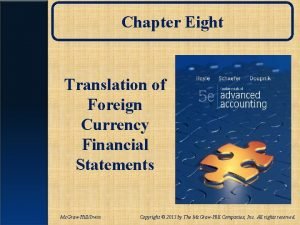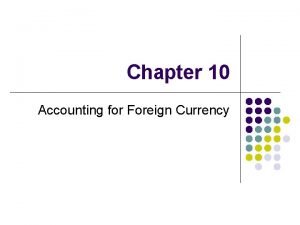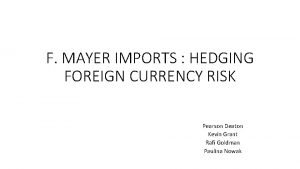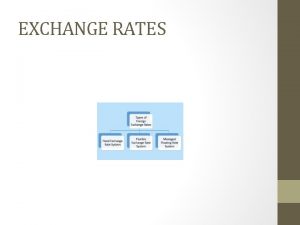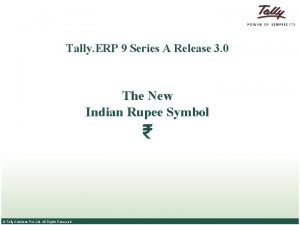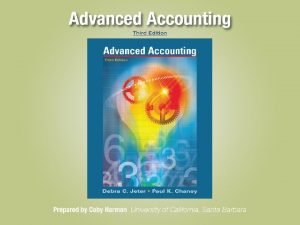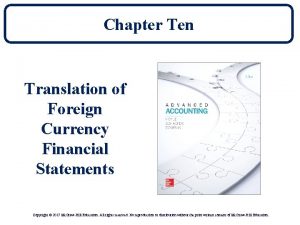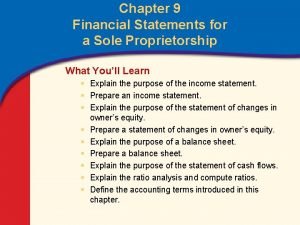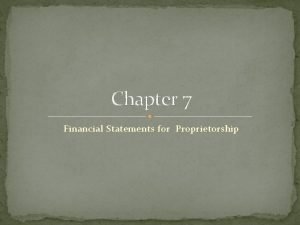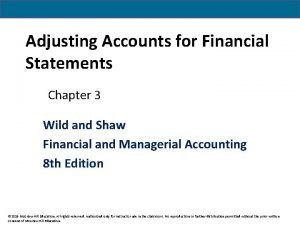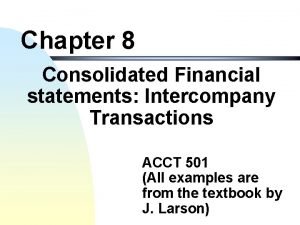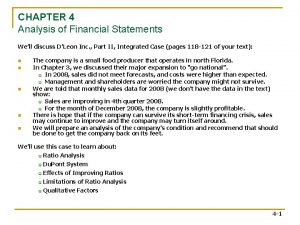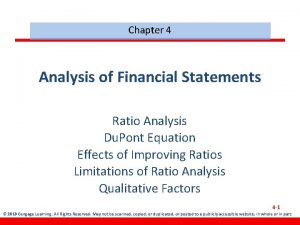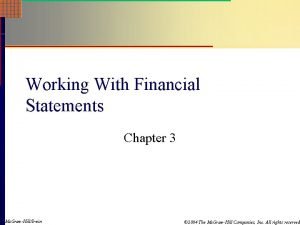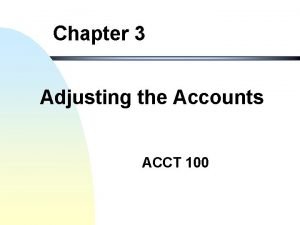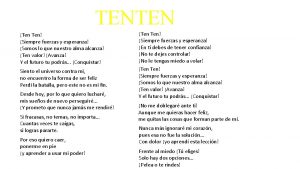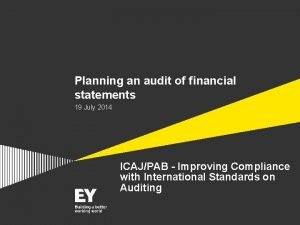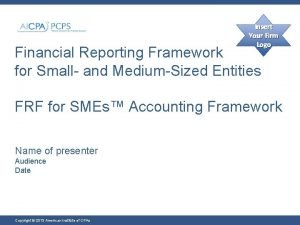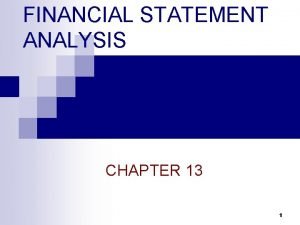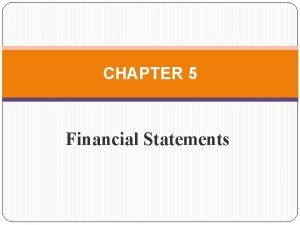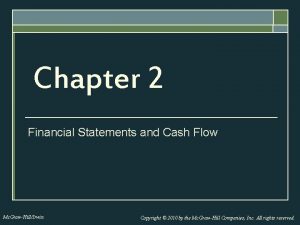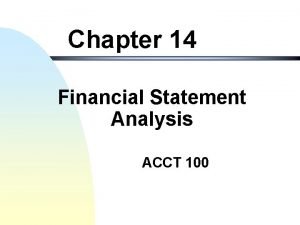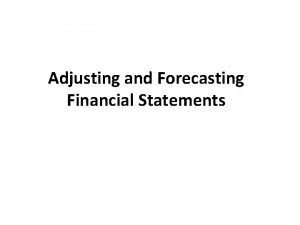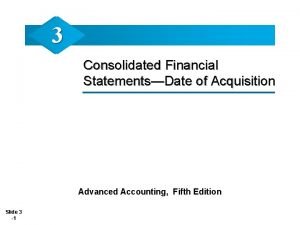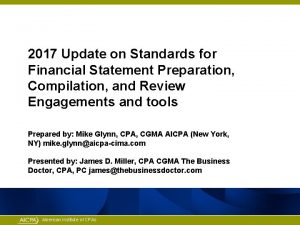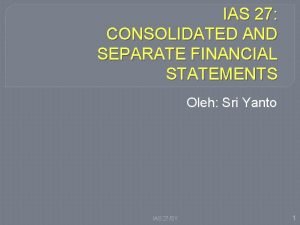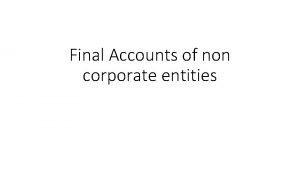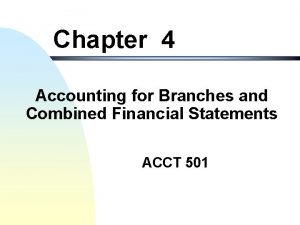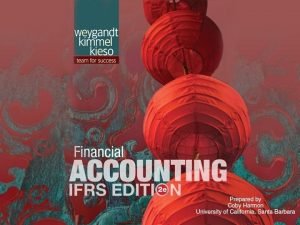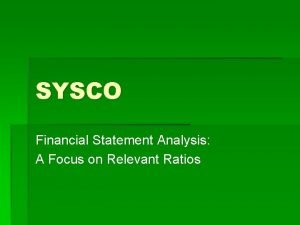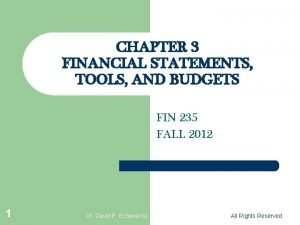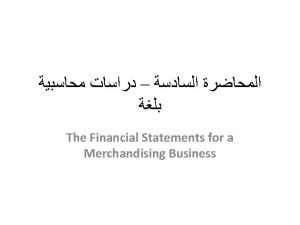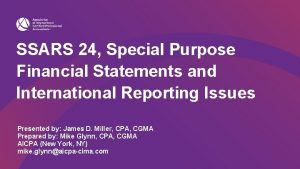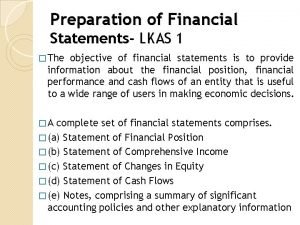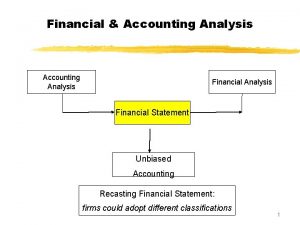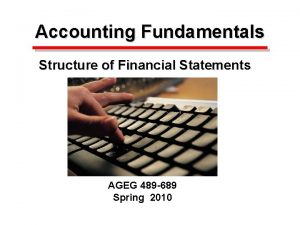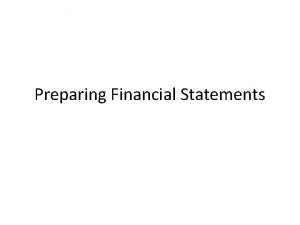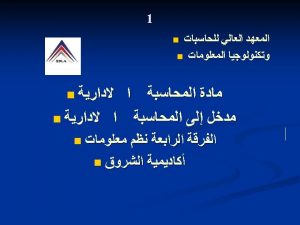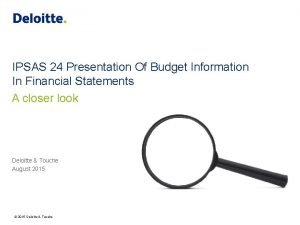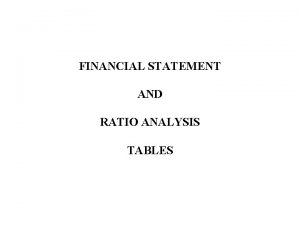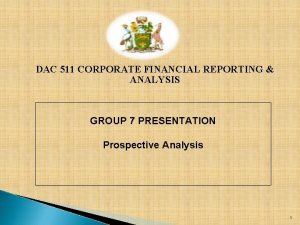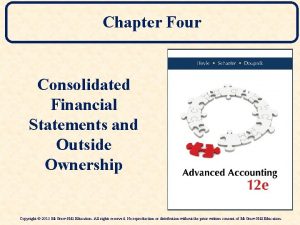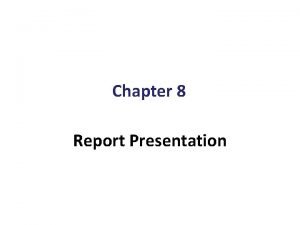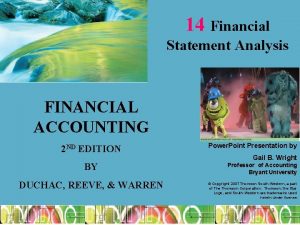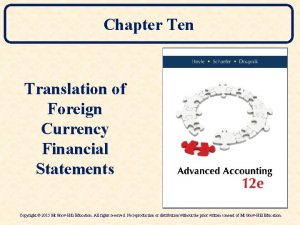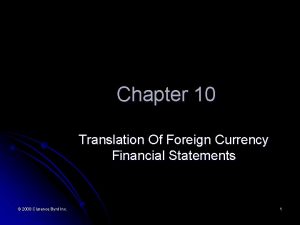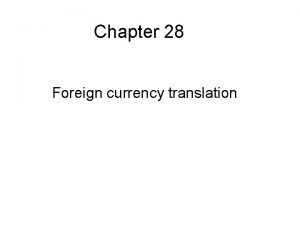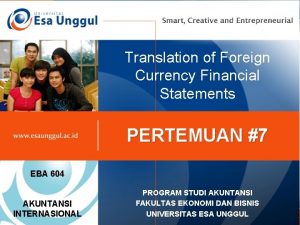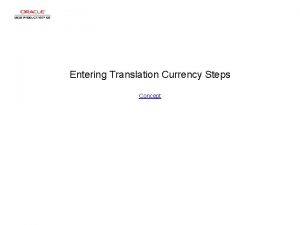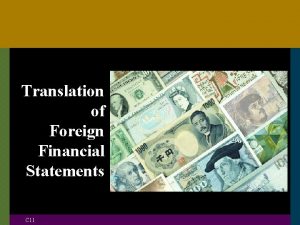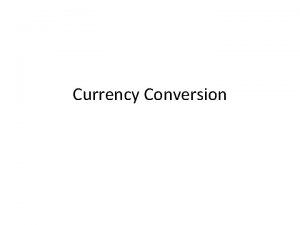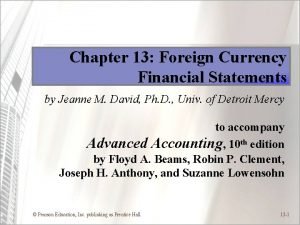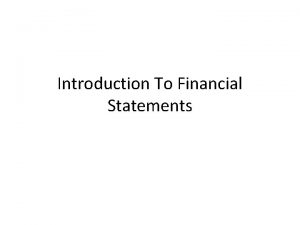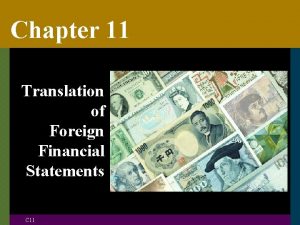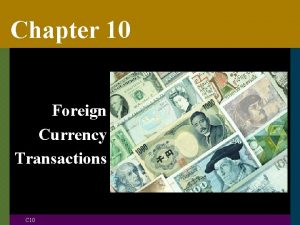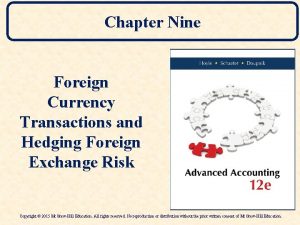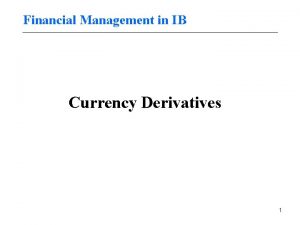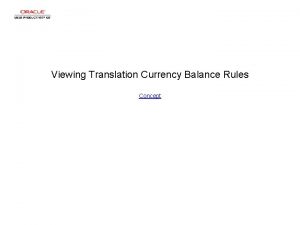Chapter Ten Translation of Foreign Currency Financial Statements






































































- Slides: 70

Chapter Ten Translation of Foreign Currency Financial Statements Copyright © 2017 Mc. Graw-Hill Education. All rights reserved. No reproduction or distribution without the prior written consent of Mc. Graw-Hill Education.

Worldwide Consolidated Financial Statements To prepare worldwide consolidated financial statements, a U. S. parent company must: 1. Convert the foreign GAAP financial statements of its foreign operations into U. S. GAAP. 2. Translate the financial statements from the foreign currency into U. S. dollars. Copyright © 2017 Mc. Graw-Hill Education. All rights reserved. No reproduction or distribution without the prior written consent of Mc. Graw-Hill Education. 10 -2

Conversion and Translation Process Ø This conversion and translation process is required whether the foreign operation is a branch, joint venture, majority-owned subsidiary, or affiliate accounted for under the equity method. Ø Two major related theoretical issues are: 1. Which translation method should be used. 2. Where the resulting translation adjustment should be reported in the consolidated financial statements. Copyright © 2017 Mc. Graw-Hill Education. All rights reserved. No reproduction or distribution without the prior written consent of Mc. Graw-Hill Education. 10 -3

Translation Methods Ø Two methods are used in the United States and most other countries to translate foreign currency financial statements into the parent company’s reporting currency. Ø Two types of exchange rates are used to apply them: 1. Historical exchange rate: the exchange rate that existed when a transaction occurred. 2. Current exchange rate: the exchange rate that exists at the balance sheet date. Ø Translation methods differ as to which balance sheet and income statement accounts are translated at historical exchange rates and at current exchange rates. Copyright © 2017 Mc. Graw-Hill Education. All rights reserved. No reproduction or distribution without the prior written consent of Mc. Graw-Hill Education. 10 -4

Translation Adjustments and Exposure Ø Assets translated at the current exchange rate when the foreign currency has appreciated generate a positive (credit) translation adjustment. Ø Liabilities translated at the current exchange rate when the foreign currency has appreciated generate a negative (debit) translation adjustment. Ø Transaction exposure gives rise to foreign exchange gains and losses that are ultimately realized in cash; translation adjustments arising from balance sheet exposure do not directly result in cash inflows or outflows. Copyright © 2017 Mc. Graw-Hill Education. All rights reserved. No reproduction or distribution without the prior written consent of Mc. Graw-Hill Education. 10 -5

Reporting Translation Adjustments Ø Should the translation adjustment be treated as a translation gain or loss reported in net income and then closed to retained earnings? Ø Should the translation adjustment be treated as a direct adjustment to owners’ equity in accumulated AOCI without affecting net income? Copyright © 2017 Mc. Graw-Hill Education. All rights reserved. No reproduction or distribution without the prior written consent of Mc. Graw-Hill Education. 10 -6

Learning Objective 10 -1 Explain theoretical underpinnings and the limitations of the current rate and temporal methods. Copyright © 2017 Mc. Graw-Hill Education. All rights reserved. No reproduction or distribution without the prior written consent of Mc. Graw-Hill Education. 10 -7

Translation Methods: Temporal and Current Rate Ø Two major translation methods are currently used: 1. The current rate (or closing rate) method. 2. The temporal method. Ø Each method is presented from the perspective of a U. S. –based multinational company translating foreign currency financial statements into U. S. dollars. Copyright © 2017 Mc. Graw-Hill Education. All rights reserved. No reproduction or distribution without the prior written consent of Mc. Graw-Hill Education. 10 -8

Current Rate Method Ø The basic assumption underlying the current rate method is that a company’s net investment in a foreign operation is exposed to foreign exchange risk. Ø A foreign operation represents a foreign currency net asset and if the foreign currency decreases in value against the U. S. dollar, a decrease in the U. S. dollar value of the foreign currency net asset occurs. Ø It will be reflected by reporting a negative (debit balance) translation adjustment in the consolidated financial statements. Copyright © 2017 Mc. Graw-Hill Education. All rights reserved. No reproduction or distribution without the prior written consent of Mc. Graw-Hill Education. 10 -9

Current Rate Method—Translation Adjustment Ø If the foreign currency increases in value, an increase in the U. S. dollar value of the net asset occurs and will be reflected through a positive (credit balance) translation adjustment. Ø To measure the net investment’s exposure to foreign exchange risk, all assets and all liabilities of the foreign operation are translated at the current exchange rate. Ø Stockholders’ equity items are translated at historical rates. Ø The balance sheet exposure under the current rate method is equal to the foreign operation’s net asset (total assets minus total liabilities) position. Copyright © 2017 Mc. Graw-Hill Education. All rights reserved. No reproduction or distribution without the prior written consent of Mc. Graw-Hill Education. 10 -10

Temporal Method Ø The basic objective underlying the temporal method of translation is to produce a set of U. S. dollar–translated financial statements as if the foreign subsidiary had actually used U. S. dollars in conducting its operations. Ø This rule is consistent with the temporal method’s underlying objective: 1. Assets and liabilities carried on the foreign operation’s balance sheet at historical cost are translated at historical exchange rates to yield an equivalent historical cost in U. S. dollars. 2. Assets and liabilities carried at a current or future value are translated at the current exchange rate to yield an equivalent current value in U. S. dollars. Copyright © 2017 Mc. Graw-Hill Education. All rights reserved. No reproduction or distribution without the prior written consent of Mc. Graw-Hill Education. 10 -11

Temporal Method Translation Adjustment Ø The major difference between a translation adjustment resulting from the use of the temporal method and a foreign exchange gain or loss is the translation adjustment is not necessarily realized through inflows or outflows of cash. Ø The U. S. dollar translation adjustment is realized only if: 1. The parent sends U. S. dollars to the foreign subsidiary to pay all of its liabilities. 2. The subsidiary converts its receivables and marketable securities into cash and then sends this amount plus the amount in its cash account to the U. S. parent, which converts it into U. S. dollars. Copyright © 2017 Mc. Graw-Hill Education. All rights reserved. No reproduction or distribution without the prior written consent of Mc. Graw-Hill Education. 10 -12

Translation of Retained Earnings Ø Stockholders’ equity items are translated at historical exchange rates under both the current rate and temporal methods. This creates somewhat of a problem in translating retained earnings. Ø Retained earnings is an accumulation of all of the net income less dividends declared by a company since its inception. Ø Keeping a record of the acquisition date exchange rates is necessary when translating inventory, prepaid expenses, property, plant and equipment, and intangible assets because these assets, carried at historical cost, are translated at historical exchange rates (not necessary under the current rate method). Copyright © 2017 Mc. Graw-Hill Education. All rights reserved. No reproduction or distribution without the prior written consent of Mc. Graw-Hill Education. 10 -13

Translation of Retained Earnings Process Ø At the end of the first year of a company’s operations, foreign currency (FC) retained earnings (R/E) is translated as follows: Ø The translated retained earnings in Year 2 (and subsequent years) are then determined as follows: Copyright © 2017 Mc. Graw-Hill Education. All rights reserved. No reproduction or distribution without the prior written consent of Mc. Graw-Hill Education. 10 -14

Calculation of Cost of Goods Sold Ø Under the current rate method, Cost of Goods Sold (COGS) in foreign currency (FC) is translated using the average-for-the-period exchange rate (ER): COGS in FC × Average ER = COGS in $ Ø Under the temporal method, no single exchange rate can be used to directly translate COGS in FC into COGS in dollars. Copyright © 2017 Mc. Graw-Hill Education. All rights reserved. No reproduction or distribution without the prior written consent of Mc. Graw-Hill Education. 10 -15

Calculation of Cost of Goods Sold (continued) Ø COGS must be decomposed into beginning inventory, purchases, and ending inventory, and each component must then be translated at its appropriate historical rate. Ø When purchases can be assumed to have been made evenly throughout 2017, the average 2017 exchange rate is used to translate purchases: Copyright © 2017 Mc. Graw-Hill Education. All rights reserved. No reproduction or distribution without the prior written consent of Mc. Graw-Hill Education. 10 -16

Inventory Translation—Current Rate and Temporal Methods Ø The current rate method requires ending inventory on the foreign currency balance sheet to be translated at the current exchange rate whether carried at cost or a lower net realizable value. Ø Application of the temporal method requires the inventory’s foreign currency cost to be translated into U. S. dollars at the historical exchange rate and foreign currency net realizable value to be translated into U. S. dollars at the current exchange rate. Copyright © 2017 Mc. Graw-Hill Education. All rights reserved. No reproduction or distribution without the prior written consent of Mc. Graw-Hill Education. 10 -17

Property, Plant, and Equipment, Depreciation, and Accumulated Depreciation Ø The temporal method requires translating property, plant, and equipment acquired at different times at different (historical) exchange rates. Ø The same is true for depreciation of property, plant, and equipment and accumulated depreciation related to property, plant, and equipment. Ø In comparison with the current rate method, the temporal method can require substantial additional work for subsidiaries that own hundreds and thousands of items of property, plant, and equipment. Copyright © 2017 Mc. Graw-Hill Education. All rights reserved. No reproduction or distribution without the prior written consent of Mc. Graw-Hill Education. 10 -18

Gain or Loss on the Sale of an Asset Ø The current rate method translates the gain on sale of land at the exchange rate in effect at the date of sale. Ø The temporal method cannot translate the gain on the sale of land directly. The cash received and the cost of the land sold must be translated into U. S. dollars separately, the difference is the U. S. dollar value of the gain. Ø The temporal method translates the Cash account at the exchange rate on the date of sale, and the Land account is translated at the historical rate. Copyright © 2017 Mc. Graw-Hill Education. All rights reserved. No reproduction or distribution without the prior written consent of Mc. Graw-Hill Education. 10 -19

Translation Adjustment Ø Two issues related to the translation of foreign currency: 1) The appropriate method for the translation of foreign currency financial statements must be selected. 2) Where to report the resulting translation adjustment in the consolidated financial statements must be decided. First method: Ø Translation gain or loss considers a translation adjustment to be a gain or loss similar to gains and losses arising from foreign currency transactions. Copyright © 2017 Mc. Graw-Hill Education. All rights reserved. No reproduction or distribution without the prior written consent of Mc. Graw-Hill Education. 10 -20

Translation Gain or Loss Ø The translation adjustment is reported in net income in the period in which the fluctuation in the exchange rate occurs. Ø Problems with treating translation adjustments as gains or losses in income is that the gain or loss is unrealized; no cash inflow or outflow accompanies it. Ø The gain or loss could be inconsistent with economic reality. Copyright © 2017 Mc. Graw-Hill Education. All rights reserved. No reproduction or distribution without the prior written consent of Mc. Graw-Hill Education. 10 -21

Cumulative Translation Adjustment Ø The alternative to reporting the translation adjustment as a gain or loss in net income is to include it in Other Comprehensive Income. Ø This treatment defers the gain or loss in stockholders’ equity (Accumulated Other Comprehensive Income or AOCI) until it is realized in some way. Ø As a balance sheet account, the cumulative translation adjustment is not closed at the end of an accounting period and fluctuates in amount over time. Copyright © 2017 Mc. Graw-Hill Education. All rights reserved. No reproduction or distribution without the prior written consent of Mc. Graw-Hill Education. 10 -22

IFRS and Translations Ø In 1975, the FASB issued SFAS 8, “Accounting for the Translation of Foreign Currency Transactions and Foreign Currency Financial Statements. ” It mandated use of the temporal method with all companies reporting translation gains or losses in net income for all foreign operations. Ø In 1981, after proposing new translation rules in two exposure drafts, FASB issued SFAS 52, “Foreign Currency Translation, ” resulting in a complete overhaul of U. S. GAAP on foreign currency translation. Ø In 2009, it was incorporated into FASB Accounting Standards Codification® (ASC) as part of Topic 830, “Foreign Currency Matters. ” Copyright © 2017 Mc. Graw-Hill Education. All rights reserved. No reproduction or distribution without the prior written consent of Mc. Graw-Hill Education. 10 -23

Learning Objective 10 -2 Describe guidelines for determining when foreign currency financial statements are to be translated using the current rate method and when they are to be remeasured using the temporal method. Copyright © 2017 Mc. Graw-Hill Education. All rights reserved. No reproduction or distribution without the prior written consent of Mc. Graw-Hill Education. 10 -24

Determining the Appropriate Translation Method Ø Some subs are so closely tied to their U. S. parents, they use a U. S. dollar perspective to translation. Most of their transactions are recorded in U. S. dollars using the temporal method as if the foreign subsidiary had actually used the dollar in carrying out its activities. Translation gains and losses are reported in net income. Ø Other subs operate relatively independent of their parents; they use a local currency perspective and use the current rate method for translation. Translation adjustments should be reported as a separate component in accumulated other comprehensive income on the balance sheet. Copyright © 2017 Mc. Graw-Hill Education. All rights reserved. No reproduction or distribution without the prior written consent of Mc. Graw-Hill Education. 10 -25

Functional Currency Ø To determine whether a subsidiary is integrated with the parent or operates independently, we look at the functional currency. Ø A company’s functional currency is the primary currency of the foreign entity’s operating environment. Functional currency orientation results in the following rule: Copyright © 2017 Mc. Graw-Hill Education. All rights reserved. No reproduction or distribution without the prior written consent of Mc. Graw-Hill Education. 10 -26

Functional Currency Terminology Ø Reporting currency: currency in which an entity prepares its financial statements. U. S. –based companies use the U. S. dollar. Ø Remeasurment: if a foreign operation’s functional currency is the U. S. dollar, the currency balances are remeasured into U. S. dollars using the temporal method resulting in remeasurement gains and losses. Ø Translation adjustment: If a foreign currency is the foreign operation’s functional currency, the currency balances are translated using the current rate method and a translation adjustment is reported on the balance sheet. Copyright © 2017 Mc. Graw-Hill Education. All rights reserved. No reproduction or distribution without the prior written consent of Mc. Graw-Hill Education. 10 -27

Highly Inflationary Economies Ø In highly inflationary economies, the temporal method for translation is required with remeasurement gains or losses reported in net income. Ø A country has a highly inflationary economy when its cumulative three year inflation exceeds 100 percent. With compounding, it equates to an average of approximately 26 percent per year for three years in a row. Ø A country may or may not be classified as highly inflationary, depending on its most recent three-year experience with inflation. Copyright © 2017 Mc. Graw-Hill Education. All rights reserved. No reproduction or distribution without the prior written consent of Mc. Graw-Hill Education. 10 -28

Indicators for Determining Functional Currency EXHIBIT 10. 2: Copyright © 2017 Mc. Graw-Hill Education. All rights reserved. No reproduction or distribution without the prior written consent of Mc. Graw-Hill Education. 10 -29

Multiple Exchange Rates Ø In some countries there is more than one rate at which the local currency can be converted into foreign currency. Ø There can be an “official rate” available from the Central Bank, and a “parallel rate” available in the open (sometimes illegal) market. Ø In some countries there is one rate for certain types of transactions and another rate for other transactions. Ø The existence of multiple exchange rates raises the question of which exchange rate to use in the financial statement translation process. Copyright © 2017 Mc. Graw-Hill Education. All rights reserved. No reproduction or distribution without the prior written consent of Mc. Graw-Hill Education. 10 -30

Appropriate Exchange Rate Ø When the temporal method is used, ASC 830 -20 -30 -3 indicates that the appropriate rate to use is the applicable rate at which a transaction could be settled, which is a matter for management judgment. Ø When the current rate method is used, ASC 830 -30 -45 -6 states that the exchange rate applicable for converting dividend remittances into U. S. dollars should be used to translate financial statements. Ø Generally, this will be the official exchange rate established by the Central Bank or other governmental authority. Copyright © 2017 Mc. Graw-Hill Education. All rights reserved. No reproduction or distribution without the prior written consent of Mc. Graw-Hill Education. 10 -31

International Accounting Standard 21 Ø IAS 21, “The Effects of Changes in Foreign Exchange Rates, ” generally follows the functional currency approach introduced by the FASB. Ø Under IAS 21, as is true under U. S. GAAP, a foreign subsidiary’s financial statements are translated using the current rate method when a foreign currency is the functional currency and are remeasured using the temporal method when the parent company’s currency is the functional currency. Copyright © 2017 Mc. Graw-Hill Education. All rights reserved. No reproduction or distribution without the prior written consent of Mc. Graw-Hill Education. 10 -32

Significant Differences between IFRS and U. S. GAAP Ø Significant differences between IFRS and U. S. GAAP relate to: a. The hierarchy of factors used to determine the functional currency. b. The method used to translate the foreign currency statements of a subsidiary located in a hyperinflationary country. Ø Factors to be considered in determining functional currency of a foreign subsidiary in IAS 21 generally are consistent with U. S. GAAP functional currency indicators. Copyright © 2017 Mc. Graw-Hill Education. All rights reserved. No reproduction or distribution without the prior written consent of Mc. Graw-Hill Education. 10 -33

Primary Factors Concerning IFRS and Translations Ø Primary factors to be considered are: 1. The currency that mainly influences sales price. 2. The currency of the country whose competitive forces and regulations mainly determine sales price. 3. The currency that mainly influences labor, material, and other costs of providing goods and services. Ø Other factors to be considered are: 1. Currency used when generating funds from financing activities. 2. Currency in which receipts from operating activities are retained. Copyright © 2017 Mc. Graw-Hill Education. All rights reserved. No reproduction or distribution without the prior written consent of Mc. Graw-Hill Education. 10 -34

Other Factors Concerning IFRS and Translations (continued) Other factors to be considered are: (continued) 3. Whether the foreign operation carries out its activities as an extension of the parent or with a significant degree of autonomy. 4. Volume of transactions with the parent. 5. Whether cash flows generated by the foreign operation directly affect the cash flows of the parent. 6. Whether cash flows generated by the foreign operation are sufficient to service its debt. Copyright © 2017 Mc. Graw-Hill Education. All rights reserved. No reproduction or distribution without the prior written consent of Mc. Graw-Hill Education. 10 -35

International Accounting Standard 21 (IAS 21) Ø IAS 21 states that when indicators (factors) are mixed and the functional currency is not obvious, the parent must give priority to the primary indicators in determining the foreign entity’s functional currency. Ø U. S. GAAP is silent with respect to weights to be assigned to various indicators to determine the functional currency and there is no hierarchy provided. Ø Under IAS 21, financial statements of a foreign subsidiary located in a hyperinflationary economy are translated into the parent’s currency using a two-step process. Copyright © 2017 Mc. Graw-Hill Education. All rights reserved. No reproduction or distribution without the prior written consent of Mc. Graw-Hill Education. 10 -36

IFRS and Translations and Hyperinflation Neither the temporal method nor the current rate method is used. 1. The financial statements are restated for local inflation in accordance with IAS 29, “Financial Reporting in Hyperinflationary Economies. ” 2. Each financial statement line item, which has been restated for local inflation, is translated using the current exchange rate. Ø Balance sheet accounts, including stockholders’ equity, are translated at the current exchange rate; a translation adjustment does not exist. Copyright © 2017 Mc. Graw-Hill Education. All rights reserved. No reproduction or distribution without the prior written consent of Mc. Graw-Hill Education. 10 -37

Characteristics That Indicate Hyperinflation Ø IAS 29 characteristics that indicate hyperinflation are: (a) The general population prefers to keep its wealth in a relatively stable foreign currency. (b) Interest rates, wages, and other prices are linked to a price index. (c) The cumulative rate of inflation over three years is approaching, or exceeds, 100 percent. Ø Under U. S. GAAP, financial statements of a foreign subsidiary located in a highly inflationary economy must be translated using the temporal method. High inflation is defined as a cumulative three-year inflation of 100 percent or more. Copyright © 2017 Mc. Graw-Hill Education. All rights reserved. No reproduction or distribution without the prior written consent of Mc. Graw-Hill Education. 10 -38

Learning Objective 10 -3 Translate a foreign subsidiary’s financial statements into its parent’s reporting currency using the current rate method and calculate the related translation adjustment. Copyright © 2017 Mc. Graw-Hill Education. All rights reserved. No reproduction or distribution without the prior written consent of Mc. Graw-Hill Education. 10 -39

Translation of Financial Statements— Current Rate Method Ø First, in translating foreign currency financial statements, determine the functional currency. Ø The amount of the cumulative translation adjustment can be determined indirectly as the amount needed to keep the translated balance sheet in balance. Ø Translate the income statement, then the statement of retained earnings, and then the balance sheet to facilitate the translation adjustment reported in the balance sheet. Copyright © 2017 Mc. Graw-Hill Education. All rights reserved. No reproduction or distribution without the prior written consent of Mc. Graw-Hill Education. 10 -40

Current Rate Method Translation of Income Statement Ø All revenues and expenses are translated at the exchange rate in effect at the date of accounting recognition. Ø Use the weighted average exchange rate if each revenue and expense is recognized evenly throughout the year. Ø When an income account, such as a gain or loss, occurs at a specific point in time, the exchange rate as of that date is applied. Copyright © 2017 Mc. Graw-Hill Education. All rights reserved. No reproduction or distribution without the prior written consent of Mc. Graw-Hill Education. 10 -41

Current Rate Method Translation of Income Statement (continued) Ø Depreciation and amortization expenses are translated at the average rate for the year. Ø These expenses accrue evenly throughout the year even though the journal entry to recognize them might not have been made until year-end for convenience. Ø The translated amount of net income for the year is taken from the income statement and entered on the statement of retained earnings. Ø Dividends are translated at the exchange rate on the date of declaration. Copyright © 2017 Mc. Graw-Hill Education. All rights reserved. No reproduction or distribution without the prior written consent of Mc. Graw-Hill Education. 10 -42

Translation Adjustments—Net Assets Ø To calculate a translation adjustment, consider the impact of exchange rate changes on the beginning balance and subsequent changes in the net asset position as follows: 1. Translate the net asset balance of the subsidiary at the beginning of the year at the exchange rate in effect that date. 2. Translate individual increases and decreases in the net asset balance during the year at the rates in effect when those increases and decreases occurred. Ø Events such as net income, dividends, stock issuance, and acquisition of treasury stock change net assets; purchase of equipment or payment of a liability does not. 10 -43 Copyright © 2017 Mc. Graw-Hill Education. All rights reserved. No reproduction or distribution without the prior written consent of Mc. Graw-Hill Education.

Translation Adjustments— Balance Sheet (continued) 3. Combine translated beginning net asset balance value and the translated value of the individual changes to arrive at the relative value of the net assets being held prior to the impact of any exchange rate fluctuations during the year. 4. Translate the ending net asset balance at the current exchange rate to determine the reported value after all exchange rate changes have occurred. Copyright © 2017 Mc. Graw-Hill Education. All rights reserved. No reproduction or distribution without the prior written consent of Mc. Graw-Hill Education. 10 -44

Translation Adjustments— Reported Values 5. Compare the translated value of the net assets prior to any rate changes (c) with the ending translated value of the individual changes (d). The difference is the result of exchange rate changes during the period. Ø If (c) is higher than (d), a negative (debit) translation adjustment exists. Ø If (d) is higher than (c), a positive (credit) translation adjustment results. Copyright © 2017 Mc. Graw-Hill Education. All rights reserved. No reproduction or distribution without the prior written consent of Mc. Graw-Hill Education. 10 -45

Learning Objective 10 -4 Remeasure a foreign subsidiary’s financial statements using the temporal method and calculate the associated remeasurement gain or loss. Copyright © 2017 Mc. Graw-Hill Education. All rights reserved. No reproduction or distribution without the prior written consent of Mc. Graw-Hill Education. 10 -46

Remeasurement Ø If the sub’s functional currency is the U. S. dollar, then any balances denominated in the local currency must be remeasured. Ø Remeasurement requires the application of the temporal method. Ø The remeasurement gain or loss must be reported in income. Ø To ensure remeasurement gain or loss is reported in income, it is easiest to remeasure the balance sheet first. Copyright © 2017 Mc. Graw-Hill Education. All rights reserved. No reproduction or distribution without the prior written consent of Mc. Graw-Hill Education. 10 -47

Remeasurement: Balance Sheet— Temporal Method Ø The temporal method remeasures cash, receivables, and liabilities into U. S. dollars using the current exchange rate. Ø Inventory, property and equipment, patents, and contributed capital accounts are remeasured at historical rates, resulting in differences in total assets and liabilities plus equity which must be reconciled, resulting in a remeasurement gain or loss. Copyright © 2017 Mc. Graw-Hill Education. All rights reserved. No reproduction or distribution without the prior written consent of Mc. Graw-Hill Education. 10 -48

Remeasurement Gain or Loss— Temporal Method Ø A remeasurement gain/loss is computed by translating the beginning net monetary asset position and subsequent changes in monetary items at appropriate exchange rates. Ø Compare that amount with the dollar value of net monetary liabilities at year-end based on the current exchange rate. Copyright © 2017 Mc. Graw-Hill Education. All rights reserved. No reproduction or distribution without the prior written consent of Mc. Graw-Hill Education. 10 -49

Remeasurement Gain or Loss— Temporal Method (continued) Ø A net monetary liability position arises over the course of the year if the foreign currency appreciation coupled with an increase in net monetary liabilities generates a remeasurement loss for the year. If the opposite occurs, a gain is recorded. Ø The ending balances in retained earnings on the balance sheet and on the statement of retained earnings must reconcile with one another. Copyright © 2017 Mc. Graw-Hill Education. All rights reserved. No reproduction or distribution without the prior written consent of Mc. Graw-Hill Education. 10 -50

Temporal Method: Income Statement– Statement of Cash Flows Ø In remeasuring the statement of cash flows, the U. S. dollar value for net income is taken from the remeasured income statement. Ø Depreciation and amortization are remeasured at the rates used in the income statement, and the remeasurement loss, a noncash item, is added back to net income. Ø Increases in accounts receivable and accounts payable, related to sales and purchases, are remeasured at the average rate. The increase in inventory is determined by the remeasurement of cost of goods sold. Copyright © 2017 Mc. Graw-Hill Education. All rights reserved. No reproduction or distribution without the prior written consent of Mc. Graw-Hill Education. 10 -51

Nonlocal Currency Balances Ø If any accounts of the foreign subsidiary are denominated in a currency other than the local currency, they would first have to be restated into the local currency. Ø Both the foreign currency balance and any related foreign exchange gain or loss would then be translated (or remeasured) into U. S. dollars. Copyright © 2017 Mc. Graw-Hill Education. All rights reserved. No reproduction or distribution without the prior written consent of Mc. Graw-Hill Education. 10 -52

Determination of Subsidiary’s Functional Currency Ø The determination of the foreign subsidiary’s functional currency (and the use of different translation methods) can have a significant impact on consolidated financial statements. Ø The current rate method does not always result in higher net income and a higher amount of equity than the temporal method. Copyright © 2017 Mc. Graw-Hill Education. All rights reserved. No reproduction or distribution without the prior written consent of Mc. Graw-Hill Education. 10 -53

Comparison of Results— Underlying Relationships Ø The temporal method distorts all of the ratios measured in the foreign currency. The subsidiary appears to be less liquid, more highly leveraged, and more profitable than it does in foreign currency terms. Ø The current rate method maintains the first three ratios but distorts return on equity, because income was translated at the average-for-the-period exchange rate, and total equity was translated at the current exchange rate. Ø Use of the average rate for income and the current rate for assets and liabilities distorts any ratio combining balance sheet and income statement figures, such as turnover ratios. Copyright © 2017 Mc. Graw-Hill Education. All rights reserved. No reproduction or distribution without the prior written consent of Mc. Graw-Hill Education. 10 -54

Learning Objective 10 -5 Understand the rationale for hedging a net investment in a foreign operation and describe the treatment of gains and losses on hedges used for this purpose. Copyright © 2017 Mc. Graw-Hill Education. All rights reserved. No reproduction or distribution without the prior written consent of Mc. Graw-Hill Education. 10 -55

Hedging Balance Sheet Exposure Ø If the U. S. dollar is the functional currency or a foreign operation is located in a highly inflationary economy, remeasurement gains and losses are reported in the consolidated income statement. Ø If the foreign currency is the functional currency, negative translation adjustments have an adverse impact on the debt-to-equity ratio. Ø Translation adjustments and remeasurement gains or losses are functions of two factors: 1. Changes in the exchange rate. 2. Balance sheet exposure. Copyright © 2017 Mc. Graw-Hill Education. All rights reserved. No reproduction or distribution without the prior written consent of Mc. Graw-Hill Education. 10 -56

Hedging Balance Sheet Exposure (continued) Ø A company has little influence on exchange rates, but parent companies can use several techniques to hedge the balance sheet exposures of their foreign operations. Ø Balance sheet exposure can be hedged through derivatives (forward contracts or foreign currency options) or through nonderivative instruments (foreign currency borrowings). Ø A hedge of a net investment in a foreign operation eliminates the possibility of a negative translation adjustment in Accumulated Other Comprehensive Income, but gains and losses realized in cash can result. Copyright © 2017 Mc. Graw-Hill Education. All rights reserved. No reproduction or distribution without the prior written consent of Mc. Graw-Hill Education. 10 -57

International Financial Reporting Standard 9—Financial Instruments Ø IFRS 9 allows hedge accounting for hedges of net investments in a foreign operation. Ø A gain or loss on the hedging instrument is recognized in Accumulated Other Comprehensive Income (AOCI) along with the translation adjustment being hedged. Ø Under both IFRS and U. S. GAAP, the cumulative translation adjustment and cumulative net gain or loss on the net investment hedge are transferred from AOCI to net income when the foreign subsidiary is sold or otherwise disposed of. Copyright © 2017 Mc. Graw-Hill Education. All rights reserved. No reproduction or distribution without the prior written consent of Mc. Graw-Hill Education. 10 -58

Disclosures Related to Translation Ø Current standards require firms to present an analysis of the change in the cumulative translation adjustment account in the financial statements or notes thereto. Ø Many companies comply with this requirement directly in their statement of comprehensive income. Other companies provide separate disclosure in the notes. Ø Although not specifically required to do so, many companies describe their translation procedures in their “summary of significant accounting policies” in the notes to the financial statements. Copyright © 2017 Mc. Graw-Hill Education. All rights reserved. No reproduction or distribution without the prior written consent of Mc. Graw-Hill Education. 10 -59

Learning Objective 10 -6 Prepare a consolidation worksheet for a parent and its foreign subsidiary. Copyright © 2017 Mc. Graw-Hill Education. All rights reserved. No reproduction or distribution without the prior written consent of Mc. Graw-Hill Education. 10 -60

Consolidation of a Foreign Subsidiary: Part I On January 1, 2016, Altman, Inc. , a U. S. -based manufacturing firm, acquired 100 percent of Bradford Ltd. in Great Britain. Altman paid 25 million British pounds (£ 25, 000), which equaled Bradford’s fair value. Bradford’s balance sheet on January 1, 2016: Cash. . . £ 925, 000 Accounts payable. . . £ 675, 000 Accounts receivable. . . 1, 400, 000 Long-term debt. . . 4, 000 Inventory. . . . . 6, 050, 000 Common stock. . . 20, 000 Property, plant & equipment (net) 19, 000 Retained earnings. . 2, 700, 000 Total. . . . . £ 27, 375, 000 Total. . . . £ 27, 375, 000 Ø The £ 2, 300, 000 excess of fair value over book value results from undervalued land (part of Property, plant & equipment) and therefore is not subject to amortization. Ø Altman uses the equity method to account for its investment in Bradford. Copyright © 2017 Mc. Graw-Hill Education. All rights reserved. No reproduction or distribution without the prior written consent of Mc. Graw-Hill Education. 10 -61

Consolidation of a Foreign Subsidiary: Part 2 On December 31, 2017, two years after the acquisition date, Bradford submitted the following trial balance for consolidation (credit balances are in parentheses): Copyright © 2017 Mc. Graw-Hill Education. All rights reserved. No reproduction or distribution without the prior written consent of Mc. Graw-Hill Education. 10 -62

Consolidation of a Foreign Subsidiary: Part 3 Ø Although Bradford generated net income of £ 1, 100, 000 in 2016, it neither declared nor paid dividends that year. Ø Other than the payment of dividends in 2017, no intra-entity transactions occurred between the two affiliates. Ø Altman has determined the British pound to be Bradford’s functional currency. Relevant exchange rates for the British pound were: Copyright © 2017 Mc. Graw-Hill Education. All rights reserved. No reproduction or distribution without the prior written consent of Mc. Graw-Hill Education. 10 -63

Consolidation of a Foreign Subsidiary: Part 4 Ø The initial step in consolidating the foreign subsidiary is to translate its trial balance from British pounds into U. S. dollars. Ø Because the British pound has been determined to be the functional currency, this translation uses the current rate method. Ø The historical exchange rate for translating Bradford’s common stock and January 1, 2016, retained earnings is the exchange rate that existed at the acquisition date—$1. 51. Copyright © 2017 Mc. Graw-Hill Education. All rights reserved. No reproduction or distribution without the prior written consent of Mc. Graw-Hill Education. 10 -64

Consolidation of a Foreign Subsidiary: Part 5 Translation of Foreign Subsidiary Trial Balance Copyright © 2017 Mc. Graw-Hill Education. All rights reserved. No reproduction or distribution without the prior written consent of Mc. Graw-Hill Education. 10 -65

Consolidation of a Foreign Subsidiary: Part 6 Ø The translation adjustment in 2016 is positive because the British pound appreciated against the U. S. dollar that year. Ø The translation adjustment in 2017 is negative because the British pound depreciated against the U. S. dollar that year. Copyright © 2017 Mc. Graw-Hill Education. All rights reserved. No reproduction or distribution without the prior written consent of Mc. Graw-Hill Education. 10 -66

Determination of Balance in Investment Ø The translation adjustment calculated each year is included in the Investment in Bradford account to update the foreign currency investment to its U. S. dollar equivalent. The counterpart is recorded as a translation adjustment on Altman’s books: Ø As a result of these two journal entries, Altman has a cumulative translation adjustment of $401, 500 on its separate balance sheet. Copyright © 2017 Mc. Graw-Hill Education. All rights reserved. No reproduction or distribution without the prior written consent of Mc. Graw-Hill Education. 10 -67

Investment in Foreign Subsidiary Account Ø The carrying value of the investment account in U. S. dollar terms at December 31, 2017, is determined as follows: Ø In addition to Altman’s $44, 783, 000 investment in Bradford, it has equity income on its December 31, 2017, trial balance in the amount of $6, 122, 500. Copyright © 2017 Mc. Graw-Hill Education. All rights reserved. No reproduction or distribution without the prior written consent of Mc. Graw-Hill Education. 10 -68

Consolidation Worksheet with Foreign Subsidiary Copyright © 2017 Mc. Graw-Hill Education. All rights reserved. No reproduction or distribution without the prior written consent of Mc. Graw-Hill Education. 10 -69

Consolidation Worksheet—Excess of Fair Value over Book Value Ø When the foreign currency is the functional currency, the excess is translated at the current exchange rate with a resulting translation adjustment. Ø The excess is not carried on either the parent’s or the subsidiary’s books but is recognized only in the consolidation worksheet. 10 -70
 Foreign currency translation example
Foreign currency translation example Forex accounting
Forex accounting F mayer imports
F mayer imports Currency exchnage
Currency exchnage Tally erp 9 symbol
Tally erp 9 symbol Translation of financial statements
Translation of financial statements Asc 830
Asc 830 Too foreign for home too foreign for here
Too foreign for home too foreign for here Financial statements and ratio analysis chapter 3
Financial statements and ratio analysis chapter 3 The expense recognition principle aims to record
The expense recognition principle aims to record Sole proprietorship income statement
Sole proprietorship income statement Chapter 7 financial statements for a proprietorship
Chapter 7 financial statements for a proprietorship Chapter 3 adjusting accounts for financial statements
Chapter 3 adjusting accounts for financial statements Chapter 8 separate financial statements
Chapter 8 separate financial statements Chapter 4 analysis of financial statements
Chapter 4 analysis of financial statements Chapter 4 analysis of financial statements
Chapter 4 analysis of financial statements How to improve current ratio
How to improve current ratio Flow chapter 2
Flow chapter 2 Working with financial statements chapter 3
Working with financial statements chapter 3 Chapter 3 adjusting accounts for financial statements
Chapter 3 adjusting accounts for financial statements Adjusting entry accrued expense
Adjusting entry accrued expense Ten twenty thirty
Ten twenty thirty Ten ten siempre fuerzas y esperanza
Ten ten siempre fuerzas y esperanza Ten ten program
Ten ten program Types of exchange rate
Types of exchange rate Sematic translation
Sematic translation Voice translation-rule
Voice translation-rule Linear parent function
Linear parent function Noun phrases
Noun phrases Financial statements purpose
Financial statements purpose Planning an audit of financial statements
Planning an audit of financial statements Sample notes to financial statements for small entities
Sample notes to financial statements for small entities Analysis of financial statements
Analysis of financial statements Fge financial management
Fge financial management 2-2 journal: financial statements and cash flow management
2-2 journal: financial statements and cash flow management Acct 100
Acct 100 Parsimonious method of forecasting
Parsimonious method of forecasting Consolidated financial statements date of acquisition
Consolidated financial statements date of acquisition Ssars 21 preparation of financial statements
Ssars 21 preparation of financial statements Constraints of accounting
Constraints of accounting Ias consolidated financial statements
Ias consolidated financial statements Standardized income statement
Standardized income statement What are non corporate entities
What are non corporate entities Accounting for branches
Accounting for branches Merchandising income statement
Merchandising income statement Four financial statements
Four financial statements Pwc ifrs 17 illustrative financial statements
Pwc ifrs 17 illustrative financial statements Unit 13 accounting and financial statements
Unit 13 accounting and financial statements Sysco financial statements
Sysco financial statements Four primary financial statements
Four primary financial statements Financial statements tools
Financial statements tools Sole trader financial statements
Sole trader financial statements Financial statements of a merchandising business
Financial statements of a merchandising business Ssars 24
Ssars 24 Lkas 7 summary
Lkas 7 summary Prospective accounting
Prospective accounting Structure of financial statements
Structure of financial statements Common sized financial statements
Common sized financial statements Petty cash in income statement
Petty cash in income statement 5 types of financial statements
5 types of financial statements Ipsas 24 summary
Ipsas 24 summary Boeing balance sheet
Boeing balance sheet Hud audited financial statements chicago
Hud audited financial statements chicago Prospective analysis financial statements
Prospective analysis financial statements Financial analysis for banks
Financial analysis for banks Partial equity method consolidation worksheet
Partial equity method consolidation worksheet Aasb 8
Aasb 8 Bank of cyprus financial statements
Bank of cyprus financial statements Pixar financial statements
Pixar financial statements Chapter 33 section 4 foreign policy after the cold war
Chapter 33 section 4 foreign policy after the cold war Foreign affairs trouble the nation
Foreign affairs trouble the nation
